
For the bulk cattle feed storage requirements, there are several options available. These include Steel drums, Round overhead storage bins, Super sacks and Commodity sheds. Depending on the size of your farm, you may install a single bulk container or multiple bulk containers. For a larger farm, you can use two bulk containers and alternate back and forth. Make sure that you don’t leave any feed stuck to the sides of the container.
Contents
Steel drums
Steel drums are one of the most important tools in the handling and storage of bulk cattle feed. They are available in different capacities and can be custom-made to fit the specific storage requirements. They can also be lined with a variety of materials, such as low-density polyethylene plastic (LDPE) or phenolic coating. Open top steel drums should have a round bottom liner, which provides a tight seal that will prevent spillage.
Steel drums have great tensile strength and material integrity. Plastic containers can be susceptible to residues and corrosion, which can have a negative effect on the contents. There are various types of drums available in the market today, including 55-gallon drums.
Round overhead storage bins
Round overhead cattle feed storage bins are designed to be as durable as possible. They come in various sizes to fit the needs of cattle producers. These bins can be equipped with different options such as J-Tubes, Drop Spouts, and Star Handles. They are ideal for feed storage and are also easy to use.
Super sacks
Super sacks are a handy tool for cattle feed storage, as they allow producers to take advantage of bulk feed prices. They require less manpower to move around than traditional 50-pound bags, which means that farmers can save time and money. Super sacks are typically made of thick woven polypropylene, which keeps air and moisture from evaporating. They are also handy for emergency feed storage, since they are large enough to hold up to 4,000 pounds of feed.
Super sacks are flexible intermediate bulk containers made of polypropylene. They are designed to be easily loaded and unloaded by a forklift and take up less space than traditional pallets. They are also highly puncture resistant. Producers can also choose a custom-designed super sack, which will contain the company’s logo.
Commodity sheds
Commodity sheds are one of the most common forms of storage for bulk cattle feed. These structures are usually made from poles and have a 6-inch concrete floor and 4-foot-high concrete foundation walls. The total cost of building one of these buildings can range from $8,000 to $30,000 depending on the size of the structure. Many dairy farms use commodity sheds for their feed storage needs. They can effectively block out rain and precipitation, so feed stored there can be kept dry.
Commodity sheds can also be used for other types of storage. For example, many operators find it convenient to have two extra bins to store pre-mix or an extra load that comes at a good price. It is also convenient to use one of these facilities to store bedding, fertilizer, and lime. Depending on the size of your facility, you may need to add more bays to accommodate the additional products you wish to store.
Grain bins
Grain bins for bulk cattle feed storage come in a variety of styles. There are high-density polyethylene (HDPE) bins that are rustproof, free of seams and rivets, and designed to protect grain from pests. Other options include metal grain bins, which are durable and come with corrugated sides for free-flowing feed.
Metal grain bins have a 20-year lifespan. The roof panels have four-inch-wide corrugations, which help the feed flow freely. A side ladder is available for easy access when filling the bin. A bulk feed bin made by Hog Slat is made of high-quality materials that will stand up to tough conditions. It is also coated with a galvanized finish, which helps it resist rust better than the industry standard G-90.
Heat-treated feeds
The process of heat-treated cattle feed storage can improve the digestibility of animal feeds. This process can be used to enhance feed digestibility by reducing the levels of acid detergent insoluble CP (ADICP) and uCP. This method has several advantages. It can be used to evaluate the protein value of animal feeds without the use of expensive and complex chemical treatments.
The use of heat-treated colostrum for cattle feed storage was found to have no adverse effect on the leukocyte count in calves. Although the absorption of colostrum would have resulted in higher peripheral total leukocyte and neutrophil counts after 24 h, no significant differences were observed between the raw colostrum and heat-treated colostrum groups. These results, however, are insufficient to fully determine the economic benefits of heat-treated colostrum.
Feed buggies
Feed buggies can be used to store, transport, and dispense bulk cattle feed. These devices are designed to keep feed free from rodents. They can be towed behind a pickup. Gravity-flow feed buggies have a sliding gate on the bottom of the bin.
Feed buggies are typically smaller than pickups and are able to tow a variety of vehicles. Powered feed buggies are similar to gravity-flow buggies, but have automatic feed dispensing mechanisms. These devices do require more maintenance and can deteriorate over time. Additionally, the tire treads can be subject to dry rot.






